八下Unit 7 Topic 2 Cooking is fun!Section D
文档属性
| 名称 | 八下Unit 7 Topic 2 Cooking is fun!Section D | 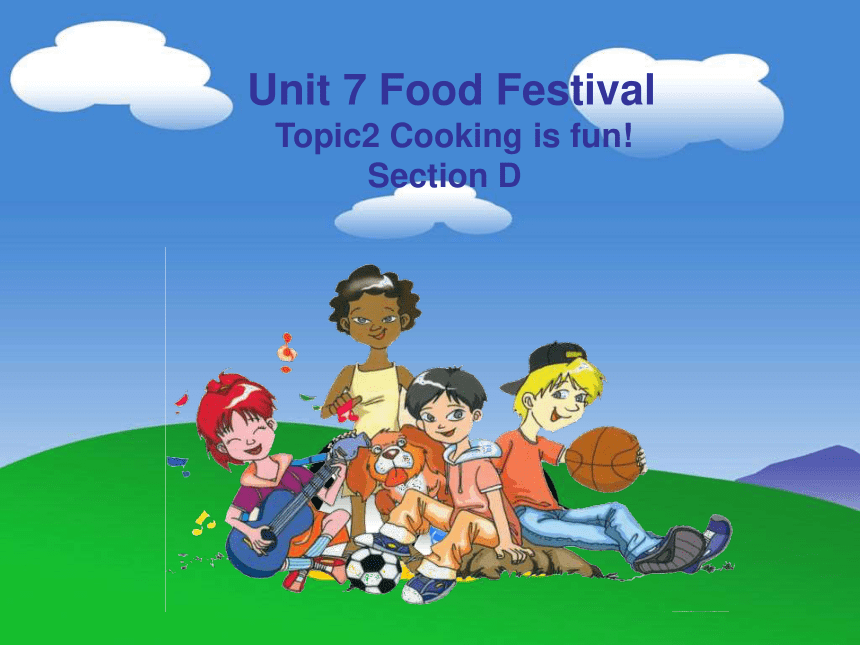 | |
| 格式 | rar | ||
| 文件大小 | 1.9MB | ||
| 资源类型 | 教案 | ||
| 版本资源 | 仁爱科普版 | ||
| 科目 | 英语 | ||
| 更新时间 | 2011-03-04 15:15:00 | ||
图片预览

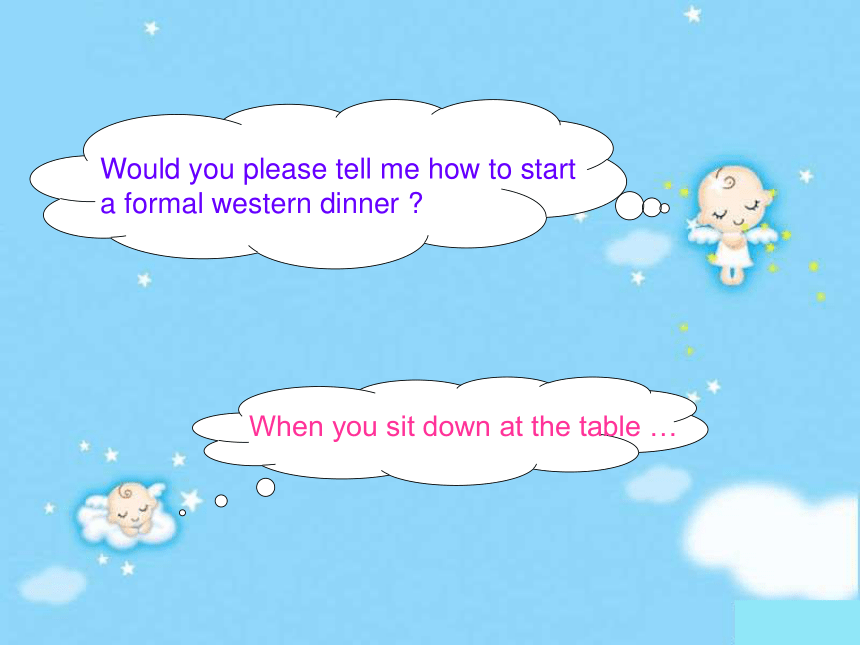
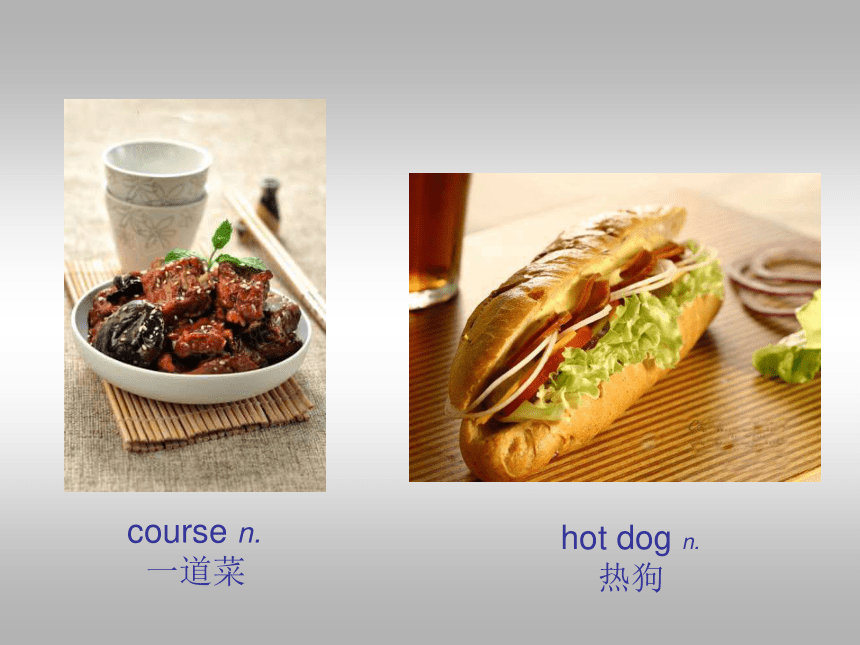
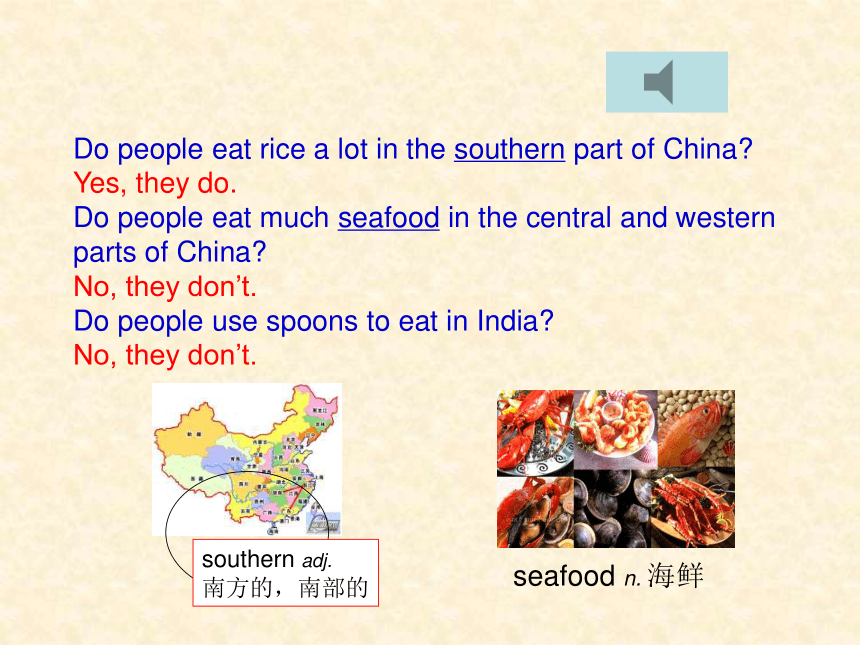
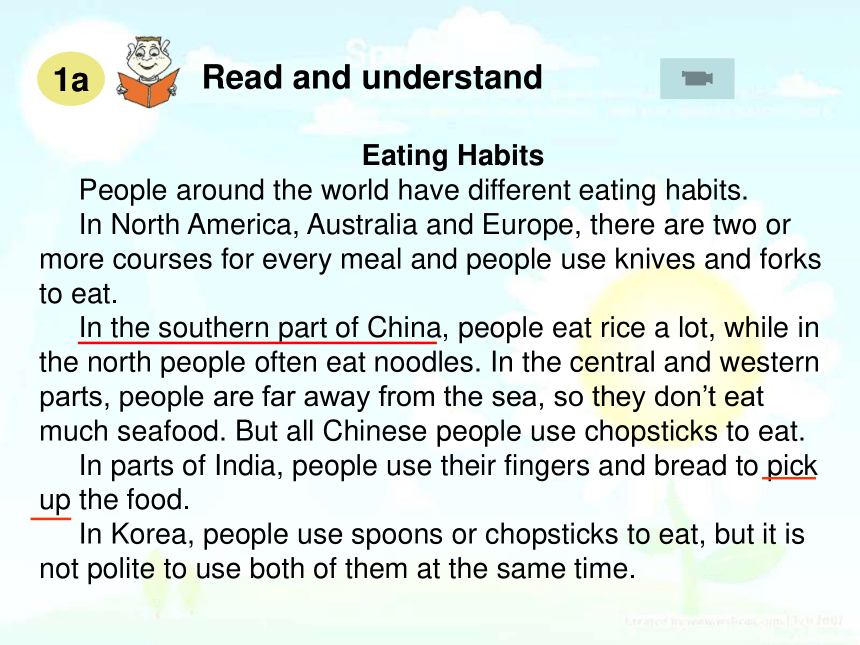

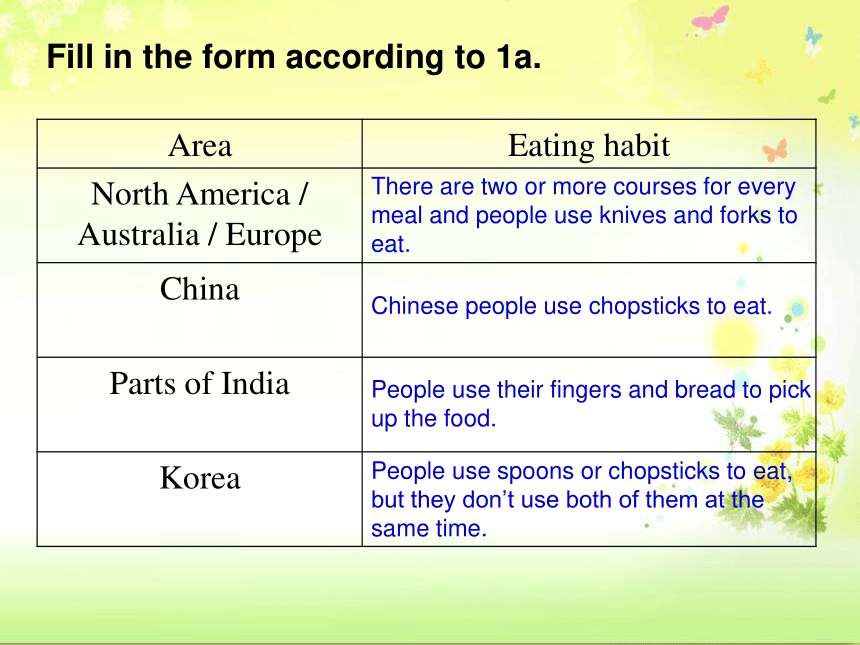
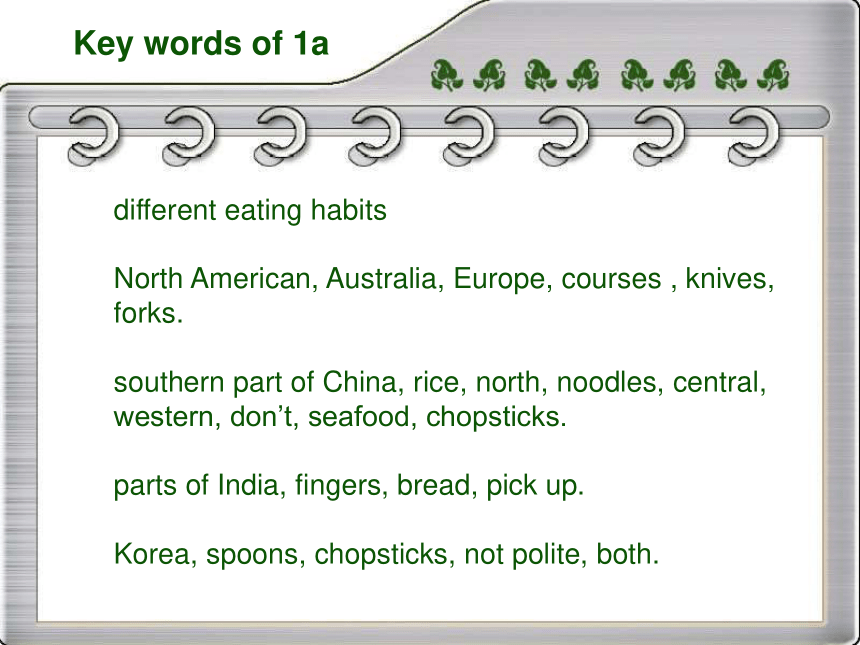
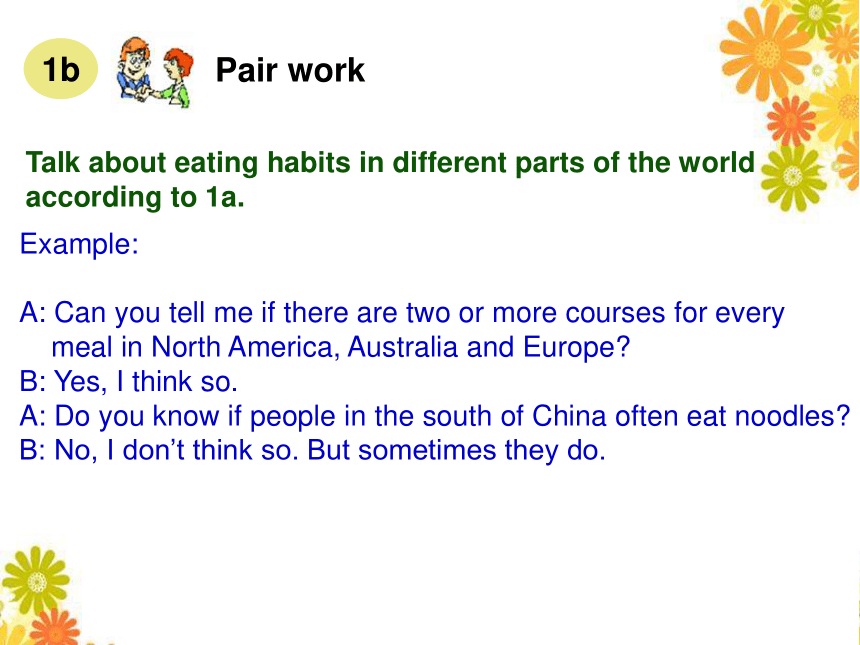
文档简介
课件20张PPT。 Unit 7 Food Festival
Topic2 Cooking is fun!
Section DWould you please tell me how to start
a formal western dinner ?When you sit down at the table …course n.
一道菜hot dog n.
热狗Do people eat rice a lot in the southern part of China?
Yes, they do.
Do people eat much seafood in the central and western
parts of China?
No, they don’t.
Do people use spoons to eat in India?
No, they don’t.southern adj.
南方的,南部的seafood n. 海鲜1aRead and understand Eating Habits
People around the world have different eating habits.
In North America, Australia and Europe, there are two or more courses for every meal and people use knives and forks to eat.
In the southern part of China, people eat rice a lot, while in the north people often eat noodles. In the central and western parts, people are far away from the sea, so they don’t eat much seafood. But all Chinese people use chopsticks to eat.
In parts of India, people use their fingers and bread to pick up the food.
In Korea, people use spoons or chopsticks to eat, but it is not polite to use both of them at the same time.pick up 拿起,捡起,接某人 如:
The phone rang and I picked it up.
电话铃响了,我拿起了电话。
My husband will pick you up.
我丈夫会来接你。 in the southern part of China
= in the south of China 在中国的南方Fill in the form according to 1a.There are two or more courses for every
meal and people use knives and forks to
eat.Chinese people use chopsticks to eat.People use their fingers and bread to pick
up the food.People use spoons or chopsticks to eat,
but they don’t use both of them at the
same time.different eating habits
North American, Australia, Europe, courses , knives,
forks.
southern part of China, rice, north, noodles, central,
western, don’t, seafood, chopsticks.
parts of India, fingers, bread, pick up.
Korea, spoons, chopsticks, not polite, both.Key words of 1a1bPair workTalk about eating habits in different parts of the world
according to 1a.Example:
A: Can you tell me if there are two or more courses for every
meal in North America, Australia and Europe?
B: Yes, I think so.
A: Do you know if people in the south of China often eat noodles?
B: No, I don’t think so. But sometimes they do.2Pair workSuppose you are Beth. Report the following interview notes
to your partner. Beth
Is the most popular food in your restaurant hot dogs?
Are the sausages in your hot dogs different from those in others?
Are Chinese dumplings your favorite Chinese food?
Do you like Chinese food? Tom
Yes, it is.
Yes, they are.
No, they aren’t.
No, not at all.Example: I ask Tom if / whether the most popular food in his restaurant
is hot dogs. And he says it is.3Written workLook at the pictures and write a passage about how to cook chicken soup.cut upwashputboil add salt,
green onionsready,
enjoyP68
3图Example: Chicken soup is very delicious, and it’s good for our health. Would you like to eat some chicken soup? Well, let’s cook it together.
First, cut up chicken. Next, wash the chicken and put it in a deep pot 70% -80% full of water. Then, boil the chicken for about 2 hours. Finally, add some salt, green onions and so on. Now the chicken soup is ready and you can enjoy it. 4aGrammar focusObject clauses (Ⅱ)But I’m not sure whether/if I can cook it well.
Can you tell me if/whether it’s polite to eat with your arms or elbows on the table in
America?
Do you know whether or not it’s impolite to smoke during a meal in France?
Maybe you don’t know whether it’s polite or not to speak loudly at the table.Comparative and superlative degrees of adverbs (Ⅰ)Jane works harder.
Wow, Michael did best of all.4bUseful expressionsFirst... Second... Next... Then... After that... Finally... Well done
Would you mind if we learn to make it from you? Of course not.
Remember not to drink too much.Activities5ProjectPrepare some hats with country names such as Japan and
Cuba on them.
Ask the students with the hats on to do some eating actions,
and the others guess and discuss:
What’s he / she doing?
Is it polite to do this during dinner in Japan / Cuba ...?
Is it polite to put arms or elbows on the table in Japan / Cuba ...?
3. Write a passage about table manners in different countries.( ) 1. Don’t worry. My father will ____ us up in the car if it rains tomorrow.
A. bring B. take C. pick
( ) 2. I don’t know ____ it’s polite or not to eat with our arms or elbows
on the table in America.
A. if B. whether C. that
( ) 3. ---Would you mind if I learn English from you?
---__________. I am very glad to teach you.
A. Of course not. B. You’d better not. C. Sounds great.
( ) 4. Yao Ming is a great basketball player. We are proud ___ him.
A. of B. to C. for
单项选择。ExercisesCBAAExercises综合短文填空。
When you go to a dinner party in the USA, you’d better bring a small present.
It’s nice to bring some d______, such as juice, beer or something like that. You
should a_____ on time or no more than five minutes late. Don’t get there e_____.
If you are going to be more than fifteen m______ late, you should call them or
let them know. Try to be relaxed and p_____. If you don’t know h____ to use
the knife and fork, don’t be nervous. You can watch other people and f_____
them. If you still have no idea, ask the person n_____ to you. If you like the
food, you should say what you t____ of it. Of course, you should thank the host
a_____ the meal. Usually a thank-you card is sent after the party.rinksrrivearlyinutesoliteowollowexthinkfter1. Learn some new words:
course, southern
2. Review object clauses:
Can you tell me if there are two or more courses for every meal in North
America, Australia and Europe?
I ask Tom if/whether the most popular food in his restaurant is hot dogs.
3. Learn different eating habits around the world:
In North America, Australia and Europe, there are two or more courses
for every meal and people use knives and forks to eat.
In Korea, people use spoons or chopsticks to eat, but it is not polite to
use both of them at the same time.
4. Review how to cook a kind of food.SummaryHomework1. Write a passage about table manners
in different countries.
2. Make a survey about table manners
in different parts of China.The end, thank you!
Topic2 Cooking is fun!
Section DWould you please tell me how to start
a formal western dinner ?When you sit down at the table …course n.
一道菜hot dog n.
热狗Do people eat rice a lot in the southern part of China?
Yes, they do.
Do people eat much seafood in the central and western
parts of China?
No, they don’t.
Do people use spoons to eat in India?
No, they don’t.southern adj.
南方的,南部的seafood n. 海鲜1aRead and understand Eating Habits
People around the world have different eating habits.
In North America, Australia and Europe, there are two or more courses for every meal and people use knives and forks to eat.
In the southern part of China, people eat rice a lot, while in the north people often eat noodles. In the central and western parts, people are far away from the sea, so they don’t eat much seafood. But all Chinese people use chopsticks to eat.
In parts of India, people use their fingers and bread to pick up the food.
In Korea, people use spoons or chopsticks to eat, but it is not polite to use both of them at the same time.pick up 拿起,捡起,接某人 如:
The phone rang and I picked it up.
电话铃响了,我拿起了电话。
My husband will pick you up.
我丈夫会来接你。 in the southern part of China
= in the south of China 在中国的南方Fill in the form according to 1a.There are two or more courses for every
meal and people use knives and forks to
eat.Chinese people use chopsticks to eat.People use their fingers and bread to pick
up the food.People use spoons or chopsticks to eat,
but they don’t use both of them at the
same time.different eating habits
North American, Australia, Europe, courses , knives,
forks.
southern part of China, rice, north, noodles, central,
western, don’t, seafood, chopsticks.
parts of India, fingers, bread, pick up.
Korea, spoons, chopsticks, not polite, both.Key words of 1a1bPair workTalk about eating habits in different parts of the world
according to 1a.Example:
A: Can you tell me if there are two or more courses for every
meal in North America, Australia and Europe?
B: Yes, I think so.
A: Do you know if people in the south of China often eat noodles?
B: No, I don’t think so. But sometimes they do.2Pair workSuppose you are Beth. Report the following interview notes
to your partner. Beth
Is the most popular food in your restaurant hot dogs?
Are the sausages in your hot dogs different from those in others?
Are Chinese dumplings your favorite Chinese food?
Do you like Chinese food? Tom
Yes, it is.
Yes, they are.
No, they aren’t.
No, not at all.Example: I ask Tom if / whether the most popular food in his restaurant
is hot dogs. And he says it is.3Written workLook at the pictures and write a passage about how to cook chicken soup.cut upwashputboil add salt,
green onionsready,
enjoyP68
3图Example: Chicken soup is very delicious, and it’s good for our health. Would you like to eat some chicken soup? Well, let’s cook it together.
First, cut up chicken. Next, wash the chicken and put it in a deep pot 70% -80% full of water. Then, boil the chicken for about 2 hours. Finally, add some salt, green onions and so on. Now the chicken soup is ready and you can enjoy it. 4aGrammar focusObject clauses (Ⅱ)But I’m not sure whether/if I can cook it well.
Can you tell me if/whether it’s polite to eat with your arms or elbows on the table in
America?
Do you know whether or not it’s impolite to smoke during a meal in France?
Maybe you don’t know whether it’s polite or not to speak loudly at the table.Comparative and superlative degrees of adverbs (Ⅰ)Jane works harder.
Wow, Michael did best of all.4bUseful expressionsFirst... Second... Next... Then... After that... Finally... Well done
Would you mind if we learn to make it from you? Of course not.
Remember not to drink too much.Activities5ProjectPrepare some hats with country names such as Japan and
Cuba on them.
Ask the students with the hats on to do some eating actions,
and the others guess and discuss:
What’s he / she doing?
Is it polite to do this during dinner in Japan / Cuba ...?
Is it polite to put arms or elbows on the table in Japan / Cuba ...?
3. Write a passage about table manners in different countries.( ) 1. Don’t worry. My father will ____ us up in the car if it rains tomorrow.
A. bring B. take C. pick
( ) 2. I don’t know ____ it’s polite or not to eat with our arms or elbows
on the table in America.
A. if B. whether C. that
( ) 3. ---Would you mind if I learn English from you?
---__________. I am very glad to teach you.
A. Of course not. B. You’d better not. C. Sounds great.
( ) 4. Yao Ming is a great basketball player. We are proud ___ him.
A. of B. to C. for
单项选择。ExercisesCBAAExercises综合短文填空。
When you go to a dinner party in the USA, you’d better bring a small present.
It’s nice to bring some d______, such as juice, beer or something like that. You
should a_____ on time or no more than five minutes late. Don’t get there e_____.
If you are going to be more than fifteen m______ late, you should call them or
let them know. Try to be relaxed and p_____. If you don’t know h____ to use
the knife and fork, don’t be nervous. You can watch other people and f_____
them. If you still have no idea, ask the person n_____ to you. If you like the
food, you should say what you t____ of it. Of course, you should thank the host
a_____ the meal. Usually a thank-you card is sent after the party.rinksrrivearlyinutesoliteowollowexthinkfter1. Learn some new words:
course, southern
2. Review object clauses:
Can you tell me if there are two or more courses for every meal in North
America, Australia and Europe?
I ask Tom if/whether the most popular food in his restaurant is hot dogs.
3. Learn different eating habits around the world:
In North America, Australia and Europe, there are two or more courses
for every meal and people use knives and forks to eat.
In Korea, people use spoons or chopsticks to eat, but it is not polite to
use both of them at the same time.
4. Review how to cook a kind of food.SummaryHomework1. Write a passage about table manners
in different countries.
2. Make a survey about table manners
in different parts of China.The end, thank you!
同课章节目录
- Unit 5 Feeling excited
- Topic 1 You look excited
- Topic 2 I’m feeling better now.
- Topic 3 Many things can affect our feelings.
- Unit 6 Enjoying Cycling
- Topic 1 We're going on a three-day visit to Mount
- Topic 2 How about exploring Tian’anmen Square?
- Topic 3 Bicycle riding is good exercise.
- Unit 7 Food festival
- Topic 1 We’re preparing for a food festival.
- Topic 2 I’m not sure whether I can cook it well.
- Topic 3 I Cooked the Most Successfully
- Unit 8 Our Clothes
- Topic 1 We will have a class fashion show.
- Topic 2 We can design our own uniforms.
- Topic 3 He said the fashion show was wonderful.
